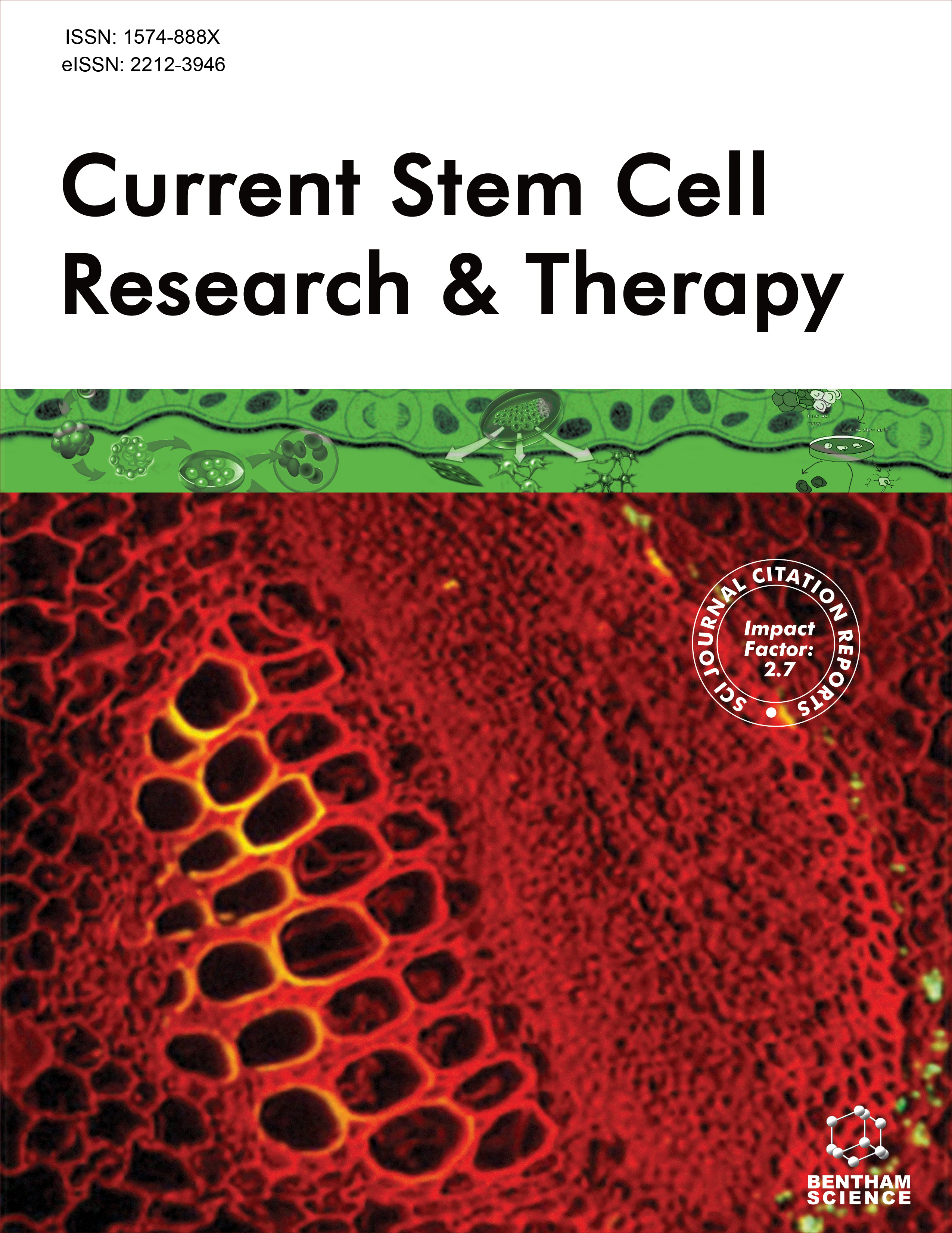Current Stem Cell Research & Therapy - Current Issue
Volume 20, Issue 3, 2025
-
-
The Application of Photobiomodulation on Mesenchymal Stem Cells and its Potential Use for Tenocyte Differentiation
More LessAuthors: Brendon Roets, Heidi Abrahamse and Anine CrousTendinopathy is a prevalent and debilitating musculoskeletal disorder. Uncertainty remains regarding its pathophysiology, but it is believed to be a combination of inflammation, damage, degenerative changes, and unsuccessful repair mechanisms. Cell-based therapy is an emerging regenerative medicine modality that uses mesenchymal stem cells (MSCs), their progeny or exosomes to promote tendon healing and r Read More
-
-
-
Assessing the Impact of Stem Cell-based Therapy on Periodontal Health: A Meta-analysis of Clinical Studies
More LessAuthors: Yu-Han Shao, Yi Song, Qiao-Li Feng, Yan Deng and Tao TangObjectiveWhile clinical trials exploring stem cells for regenerating periodontal tissues have demonstrated positive results, there is a limited availability of systematic literature reviews on this subject. To gain a more comprehensive understanding of stem cell interventions in periodontal regeneration, this meta-analysis is undertaken to assess the beneficial effects of stem cells in human periodontal regeneration.Methods“ Read More
-
-
-
HucMSCs-derived Exosomes Protect Against 6-hydroxydopamine- induced Parkinson’s Disease in Rats by Inhibiting Caspase-3 Expression and Suppressing Apoptosis
More LessAuthors: Hong-Xu Chen, Hong-Jun Xu, Wang Zhang, Zi-Yu Luo, Zhong-Xia Zhang, Hao-Han Shi, Yu-Chang Dong, Zhan-Jun Xie, Ying Ben and Sheng-Jun AnObjectiveParkinson’s disease (PD) is a progressive neurodegenerative disorder with symptoms including tremor and bradykinesia, while traditional dopamine replacement therapy and hypothalamic deep brain stimulation can temporarily relieve patients’ symptoms, they cannot cure the disease. Hence, discovering new methods is crucial to designing more effective therapeutic approaches to address the condition. In our Read More
-
-
-
Efficacy and Safety of Human Umbilical Cord Mesenchymal Stem Cells in Improving Fertility in Polycystic Ovary Syndrome Mice
More LessAuthors: Lukuo Jin, Chenchen Ren, Li Yang, Yuanhang Zhu, Genxia Li, Yun Chang, Junxiao Du, Zhaoyuan Yang and Yuchao YuanBackgroundPolycystic ovary syndrome (PCOS) is the most prevalent reproductive endocrine illness in women of reproductive age and is one of the most important causes of female infertility. The pathogenesis of PCOS is complex. Although mesenchymal stem cell therapy is anticipated to be a successful treatment for PCOS, its long-term safety, including tumorigenesis in patients, remains unknown.ObjectiveThis study aimed to Read More
-
-
-
Role of Menstrual Blood Stem Cell-Derived Secretome, Follicular Fluid, and Melatonin in Oocyte Maturation and Embryo Development in Polycystic Ovary Syndrome
More LessAuthors: Hilda Rastegari, Somaieh Kazemnejad, Nasim Hayati Roodbari and Soheila AnsaripourBackgroundIn vitro maturation has been considered an approach to mature oocytes derived from women with polycystic ovary syndrome (PCOS). It is suggested that the IVM of oocytes may benefit from mesenchymal stem cells derived conditioned medium (CM-MSC).ObjectiveThe purpose of this study was to determine the efficacy of a cocktail of menstrual blood stem cell (MenSCs)-derived secretome, along with follicular flui Read More
-
-
-
Human Umbilical Cord Mesenchymal Stem Cell-derived Exosome Regulates Intestinal Type 2 Immunity
More LessAuthors: Jiajun Wu, Zhen Yang, Daoyuan Wang, Yihui Xiao, Jia Shao and Kaiqun RenAimsThe aim of this study was to investigate the role of human umbilical cord mesenchymal stem cell-derived exosomes (hUCMSC-Exo) in regulating the intestinal type 2 immune response for either protection or therapy.BackgroundhUCMSC-Exo was considered a novel cell-free therapeutic product that shows promise in the treatment of various diseases. Type 2 immunity is a protective immune response classifie Read More
-
-
-
The Low Tumorigenic Risk and Subtypes of Cardiomyocytes Derived from Human-induced Pluripotent Stem Cells
More LessAuthors: Jizhen Lu, Lu Zhang, Hongxia Cao, Xiaoxue Ma, Zhihui Bai, Hanyu Zhu, Yiyao Qi, Shoumei Zhang, Peng Zhang, Zhiying He, Huangtian Yang, Zhongmin Liu and Wenwen JiaBackgroundClinical application of human induced pluripotent stem cell-derived cardiomyocytes (hiPSC-CMs) is a promising approach for the treatment of heart diseases. However, the tumorigenicity of hiPSC-CMs remains a concern for their clinical applications and the composition of the hiPSC-CM subtypes need to be clearly identified.MethodsIn the present study, hiPSC-CMs were induced from hiPSCs via modulation of W Read More
-
-
-
Examining the Synergic Effect of Exosomes Derived from Mouse Mesenchymal Stem Cells and Low-frequency Electromagnetic Field on Chondrogenic Differentiation
More LessAuthors: Maryam Lotfi, Javad Baharara, Khadije Nejad Shahrokhabadi and Pejman KhorshidBackgroundCartilage has intrinsically limited healing power, and regeneration of cartilage damages has remained a challenge. Secreted products of mesenchymal stem cells have shown a new therapeutic strategies for cartilage injuries. Also it has been observed that low frequency electromagnetic field plays a key role in biological processes.ObjectiveThis research was performed to investigate the synergic effect of Read More
-
-
-
Umbilical Cord Blood and UC-MSCs Combined with Low-Dose Immunosuppressant in the Treatment of Elderly Patients with Pure Red Cell Aplastic: A Case Series
More LessAuthors: Wei-Wei Zhu, Sujing Zhuang, Zhe Yu, Xin Li, Tian-Jie Han, Yue Ma, Li-Jun Li and Zhi-Rui ZhaoIntroductionAt present, cyclosporine (CsA) is the first-line treatment for Pure Red Cell Aplasia (PRCA), but CsA administration can be associated with a number of side effects due to its high toxicity. Therefore, it is urgent to explore a safe and effective treatment for elderly patients who cannot be treated with conventional doses of CsA, especially those with multiple complications. Allogeneic Stem Cell Transplantation (ASCT) for PR Read More
-
Volumes & issues
-
Volume 20 (2025)
-
Volume 19 (2024)
-
Volume 18 (2023)
-
Volume 17 (2022)
-
Volume 16 (2021)
-
Volume 15 (2020)
-
Volume 14 (2019)
-
Volume 13 (2018)
-
Volume 12 (2017)
-
Volume 11 (2016)
-
Volume 10 (2015)
-
Volume 9 (2014)
-
Volume 8 (2013)
-
Volume 7 (2012)
-
Volume 6 (2011)
-
Volume 5 (2010)
-
Volume 4 (2009)
-
Volume 3 (2008)
-
Volume 2 (2007)
-
Volume 1 (2006)
Most Read This Month Most Read RSS feed
Article
content/journals/cscr
Journal
10
5
false
en


